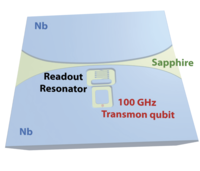- PDF - 802.6 kio
Phd Position
Towards a 100GHz qubit
A New Platform for Condensed Matter Physics
Superconducting quantum circuits, recently recognized by the Nobel Prize in Physics, open up a fascinating field of research for studying and manipulating quantum phenomena at the macroscopic scale. Over the past few decades, these circuits have enabled the creation and control of superconducting qubits, the fundamental building blocks of quantum information. They have made it possible to perform circuit quantum electrodynamics (cQED) experiments, where light and matter interact in a fully quantum manner [1].
However, most of these experiments, based on Aluminium, Aluminium Oxide materials, operate in the microwave frequency range (a few GHz). Recent work has shown that materials such as niobium (Nb) and niobium nitride (NbN) can be used to design resonators and qubits operating at much higher frequencies >100GHz [2], while many condensed matter excitations — such as plasmons in GaAs quantum wells or magnons in ferromagnetic materials — occur at much higher frequencies, in the sub-THz range (energies on the order of meV).

During this thesis, you will first build a Nb Josephson junction and characterize it at low temperature. You will then design and fabricate a mm-Wave qubit operating at a frequency of 100 GHz. A sub-THz resonator, dispersively coupled to the qubit, will allow for the readout of the state of the qubit. You will learn how to perform state of the art cQED measurement at cryogenic temperatures to characterize the properties of the qubit. You will extract the coherence times (T1 and T2) of the qubit and it’s energy as a function of the tuning parameters.
In the long term, the tunable transmon can then be coupled to a cavity to generate non-classical states of light, or to a magnetic or semi-conducting material to probe coherently fundamental excitations such as plasmons or magnons. This is part of a current effort to apply quantum technologies for the understanding of condensed matter systems. This PhD project is funded together with an other PhD to develop Dynamical Coulomb Blockade (DCB) detectors. This DCB detector can perform a non-demolition measurement of the quantum state of the cavity.
Objectives : The goal of this PhD is to design and fabricate a mm-Wave qubit [2], and a mm-Wave readout resonator. A strong background in quantum mechanics and a taste for simulations and Python coding are recommended.
Contact : alexis.jouan@espci.fr and cheryl.feuilletpalma@espci.fr
[1] A. Blais, A. L. Grimsmo, S. Girvin, and A. Wallraff, “Circuit quantum electrodynamics,” vol. 93.
[2] A. Anferov, S. P. Harvey, F. Wan, J. Simon, and D. I. Schuster, “Superconducting qubits above 20 ghz operating over 200 mk,” PRX Quantum, vol. 5, no. 3, 2024.
- PDF - 802.6 kio